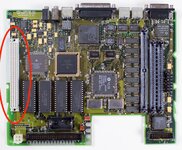Sideburn
Well-known member
Hi, does anyone know if a Nubus card should show activity on the address/data lines if just power is applied to the card from a non working / running Mac logic board?
I have a Radius Rocket card that’s not working and I was going to try to troubleshoot it but I can’t tell if Nubus cards need a running Mac or not to talk to the card to and make it start running or not.
When I put the card in a functioning iicx, it’s dead and doesn’t show up on the Nubus using tattletech etc. all I see is the video card.
So in order to work on it on the bench all I have is a sick iicx board that powers on but it’s also not working.
I’m hoping I can just supply the 5V / 12v to the card and know that the cpu should be running. All I am seeing is a clock and no other activity.
There’s probably not much hope since I can’t find any schematics either but it would help to at least have an understanding of how Nubus works.
I have a Radius Rocket card that’s not working and I was going to try to troubleshoot it but I can’t tell if Nubus cards need a running Mac or not to talk to the card to and make it start running or not.
When I put the card in a functioning iicx, it’s dead and doesn’t show up on the Nubus using tattletech etc. all I see is the video card.
So in order to work on it on the bench all I have is a sick iicx board that powers on but it’s also not working.
I’m hoping I can just supply the 5V / 12v to the card and know that the cpu should be running. All I am seeing is a clock and no other activity.
There’s probably not much hope since I can’t find any schematics either but it would help to at least have an understanding of how Nubus works.

